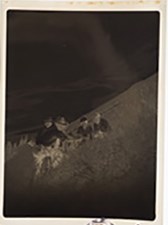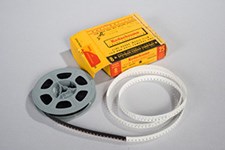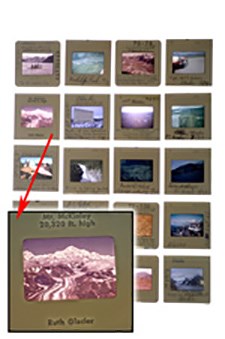Film Identification
The history of film is complex. Even in the late 19th century, scientists and photographers were already experimenting and developing applications for this new flexible media. The timeline provided below will serve as a valuable tool to assist you in understanding the nature of film-based materials in your collection. Using any available information on the date that an image was created, along with its film format, will help you in the film identification process.

- 1889 – Introduction of cellulose nitrate roll film (not 35 mm) by Eastman Kodak Company
- 1895 – Introduction of cellulose nitrate motion picture film

- 1912 – Cellulose nitrate sheet films and film packs were marketed (Eastman Kodak Company). About this same time X-ray film was also made available in cellulose nitrate
- 1920 – Cellulose nitrate 35 mm roll film and aerial film is available
- ca. 1922 – Cellulose diacetate (a specific type of “cellulose acetate”) was introduced for 16 mm film. (Eastman Kodak Company). Cellulose nitrate was never used for 16 mm film

- ca. 1925 – Cellulose diacetate sheet film introduced (Eastman Kodak Company)
- ca. 1930 – Edge marking cellulose nitrate with “Nitrate” begins. Cellulose diacetate was being marked with “Safety” to distinguish the two. Cellulose acetate x-ray film and microfilm starts to replace cellulose nitrate as the production of cellulose nitrate is halted.
- 1932 - Cellulose diacetate (a specific type of “cellulose acetate”) was introduced for 8 mm film. (Eastman Kodak Company). Cellulose nitrate was never used for 8 mm film

- 1933 – Last year Eastman Kodak manufactures cellulose nitrate x-ray film
-
1935 – Kodachrome slide film first introduced (cellulose acetate base)
- ca. 1935 – Agfa, Defender, DuPont Defender and Hammer produced cellulose diacetate films
- 1938 – Discontinuation of 35 mm cellulose nitrate roll film. However, still photographers were known to use cellulose nitrate 35mm motion picture film after this date.
- 1939 – Discontinuation of portrait and commercial cellulose nitrate sheet film
- 1940 – Cellulose acetate aerial film is developed
- 1942 – First color negatives on a cellulose acetate base, Kodacolor. Cellulose nitrate aerial film is discontinued

- 1949 – Discontinuation of cellulose nitrate film packs
- ca. 1950 – Cellulose triacetate (a specific type of “cellulose acetate”) started being widely produced and quickly takes over the cellulose diacetate market. Today it is still the most widely used film-base for amateur rolled film and motion picture film (color and B&W)
- 1951 – Discontinuation of the production of cellulose nitrate motion picture film by the Eastman Kodak Company (other companies may have produced it for a few more years into the late 1950’s)
- 1955 – First polyester-based films (most commonly found in: sheet films after 1970s, x-ray films after 1955, aerial films after 1960s).
- NB—Film stocks were used until depleted even after the final date of manufacture.
Last updated: December 18, 2019
